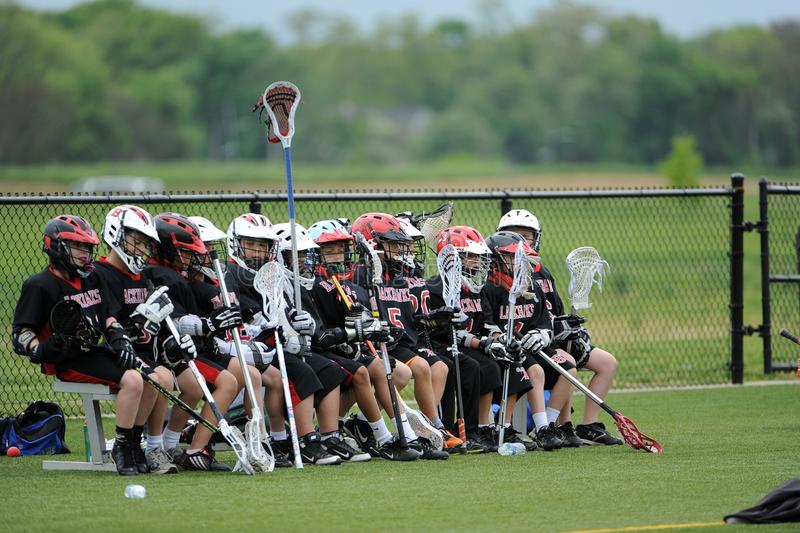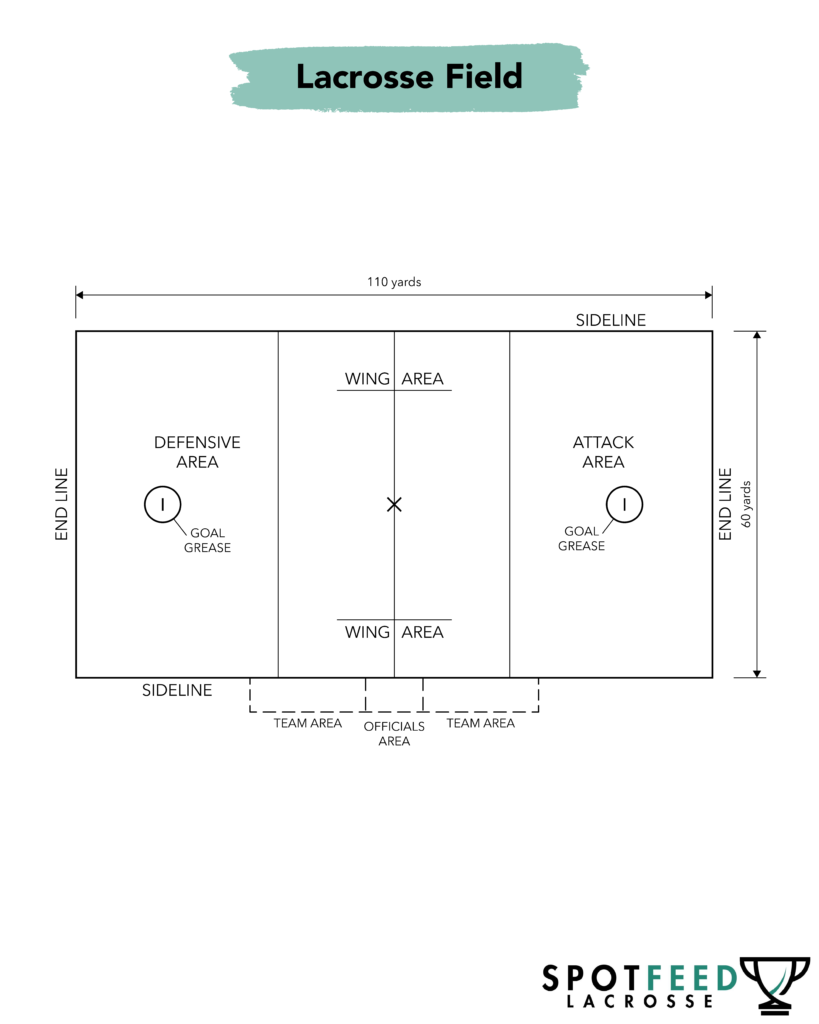Is your first lacrosse game coming up and you’re unsure of what to expect? Not sure how long the game will take? When you should cheer? What terms will be helpful for you to understand? No problem – this is normal for everyone new to the game! Whether you’re getting ready for a youth or a high school lacrosse game, read on so that you can hit the ground running.

Table of Contents
How Long is a Youth Lacrosse Game? A High School Lacrosse Game?
Youth and high school lacrosse games follow the same format: four quarters that last between 10 and 12 minutes of live-game-action per quarter (the exact length can depend on the specific league rules). There is a break after each quarter that only lasts a few minutes, with a 10 minute break at halftime.
The officials usually stop the game clock when goals are scored, when the ball goes out of bounds, as well as for penalties, injuries, and timeouts. All told, you can expect a quarter of live-game-action to take about 20 minutes with clock stoppages. If the teams are tied at the end of regulation time, overtime is played in four-minute increments of sudden-death, until one side scores.
How Many Goals are Typically Scored in a Lacrosse Game?
Scoring will naturally vary by team and by game, but you can usually expect each side to score in the single digits or low double digits. Some leagues may have a “mercy rule” in place: If one team leads the other by a certain number of goals – for example, a score of 12-2 for a 10-goal lead – the game can switch to “running time.”
“Running time” means that the clock keeps running after penalties, goals, and other events that would normally cause the clock to stop. The mercy rule is typically used in youth leagues. It’s rare to see the mercy rule used at the high school level, although it may occasionally happen with permission from both coaches. Check your league’s rulebook for specifics on how the mercy rule works for you.
What Key Moments Should You Watch for at Your First Lacrosse Game?
Goals are obviously exciting moments during your first lacrosse game, but there are lots of other moments throughout the game that are critical to a team’s success. The unsung hero moments? Groundballs. Most coaches agree that groundballs are the most important factor for their team’s success.
The team that picks up the most ground balls usually wins. Why? Because groundballs lead to more scoring opportunities, and are often an indicator of a team’s hustle and effort. Some groundballs are easy to pick up, while others may involve many players converging on a loose ball to try and gain possession for their team. These are often some of the more exciting moments of the game.
“Fast breaks” offer other exciting moments. This term refers to an advantageous scoring opportunity when an offensive player carries the ball into the defensive half of the field unguarded, creating a 4-on-3 scoring chance. Offensive players briefly outnumber defenders while the opposing team’s midfielders hustle back to help, which provides a strong opportunity for the offense. Watch for quick passing from the offense in an attempt to get an easy scoring opportunity, and fast reactions from the defense as they try to “buy time” for their teammates to hustle back and help.
When the defending team prevents the offense from scoring, there is often an “unsettled clear”. This term refers to a quick change of possession, in which both teams must rapidly shift strategies. The team that was just defending now must “clear” the ball to their offensive half of the field. Unsettled clears often happen when the goalie makes a save or when the defense forces a turnover. Unexpected changes in possession often lead to easy opportunities to advance the ball and create good scoring opportunities.
What’s That Yellow Flag, and Why was What Whistle Blown?
There are two types of fouls in lacrosse: technical and personal. Technical fouls relate more to game rules and fairness, while personal fouls are more about safety, and carry stronger penalties accordingly.
Fouls play out differently depending on whether or not the foul was committed by the team with the ball. If the attacking team commits a foul, the referee blows the whistle and play stops. If the defending team is at fault, though, teams play on until the ball changes possession, preserving the possession and scoring chances of the attacking team. When that happens, the referee throws a yellow flag to mark the foul without stopping play.
Assuming the penalty isn’t waved off, the player who committed the foul will have to spend some time in the penalty box at the sidelines. His team will play a man down while they wait for him to be released.
For a technical foul, the offending player must wait in the penalty box for 30 seconds while his team plays defense without him. For a personal foul, the offending player must wait in the penalty box for 60 seconds. In lacrosse, the team that benefits from the penalty is said to go “man up”–meaning they have an advantage of an extra man on the field for the duration of the penalty.
What are Some Terms to Listen for at Your First Lacrosse Game?
Here are a few other terms to get you oriented at your first lacrosse game. If you really want to brush up your lacrosse jargon, you can visit SpotFeed’s Lacrosse Terminology page, here.
Field terms
- Crease: The circle around the goal designed to protect the goalie. Only defensive players can enter the crease.
- GLE (Goal line extended): An imaginary line extending out from the sides of the goal to the sidelines. This is an important boundary for defenders, because an offensive player has no good angle to shoot from behind the goal.
- Faceoff: A term used to describe the sequence that occurs to start each quarter (and after each goal is scored), to determine which team will win possession of the ball. Similar to a “jump ball” in basketball.
- Midfield line: The line in the center of the field separating the offensive and defensive halves. Faceoffs and substitutions happen along the midfield line.

Positions
- Attack/attackman: One of three players who remain on the offensive half of the field. Primarily focused on scoring goals.
- Defenseman: One of three players who remain on the defensive half of the field. Defensemen are focused on preventing the offense from scoring.
- Goalie: The last line of defense, charged with stopping shots on the goal.
- Midfielders/middies: Versatile players who can cross the midfield line. They play both defense and offense, and move the ball from one to the other during transition situations.
- LSM (Long-Stick-Midfielder): A defensive-minded midfielder who carries a long pole and runs onto the field only when his team is playing defense (this specialty position is not often used at the youth level).
- FOGO (Face Off, Get Off): A term used to describe a midfielder who specializes in winning the face off.
Now get out there and enjoy your first lacrosse game! When you’re ready to dive deeper into the techniques and tactics of lacrosse, come back and visit the site again. We have the advice and resources to help you build a rewarding relationship with this fast-growing sport.
FAQs
At the beginning of a lacrosse game, the referee will set the ball at the center of the field and one player from each side will crouch down in this area on opposite sides of the ball. When the referee blows the whistle, the game begins with a “faceoff,” as each player tries to win possession of the ball for his team by trying to scoop it up with his stick before his opponent does. This is just like a faceoff in hockey or a tipoff in basketball.
The average youth lacrosse game should last somewhere between 60 and 90 minutes, so plan accordingly for your first game. The breakdown of time consists of 4 quarters, 10-12 minutes each (depending on the league), with a 10-minute halftime break. Some youth leagues play with a running clock, which means there are no clock stoppages for things that would normally pause the clock like penalties or changes in possession. This is why some games can be as short as 60 minutes, while others (in cases of not using a running clock) can be a bit longer.
